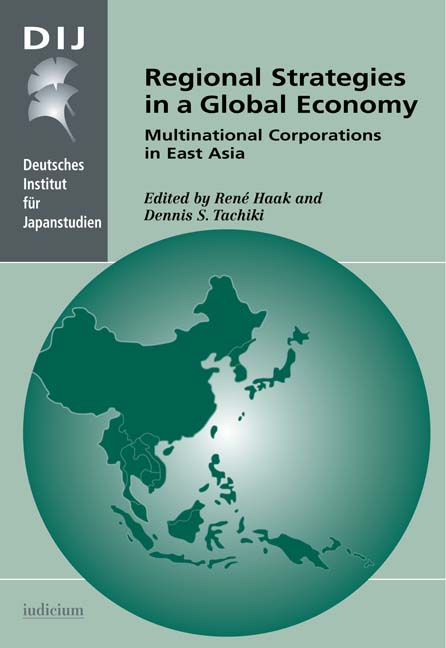Japan und Ostasien
Germanistik /
Deutsch als Fremdsprache
Kulinaristik
Kulturwissenschaften
|
 |
Senden Sie Fragen oder Kommentare zu dieser Website an:
info@iudicium.de
iudicium verlag
Dauthendeystr. 2 · 81377 München
Deutschland
Copyright · 2024
|
|
| |
|
 Haak,
René / Tachiki, Dennis S. (eds.) Haak,
René / Tachiki, Dennis S. (eds.)
Regional Strategies in a Global Economy.
Multinational Corporations in East Asia
2004 • ISBN 978-3-89129-848-0 •290 Seiten, geb. · EUR
41,-
Deutsches Institut für Japanstudien (Hg.):
Monographien, herausgegeben vom Deutschen Institut für Japanstudien (Bd. 38)
Both proponents and opponents of globalization assume it
is a process that sweeps across national borders. Indeed, over the last
twenty years, the key features of globalization provide prima facie evidence
for this conventional wisdom. Dramatic developments in information and
communications technology, the rise of global companies and production
networks, the unstoppable internationalization of financial markets, and the
deregulation and privatization of service sectors are all important examples
of how this process unfolds in its raw form. Nevertheless, the increase in
regional economic activity is another striking feature of this process. As
multinational corporations extend their global reach, regional networks also
emerge in the global trading system. Globalization therefore does not only
mean a global convolution of economies, but could also lead to a spatial
concentration of economic activity. All through the 1990s and at the
beginning of the new century, East Asia experienced numerous structural
changes leading to interesting market developments. South Korea’s rise to
developed country status, the integration of the Southeast Asian economies,
and the rise of China have made this region the manufacturing center of the
global economy. Considering the economic importance of Japan and the other
East Asian nations in the world, the crucial questions that arise include:
What are the linkages between the global strategies of multinational
corporations and their regional business operations? Why do subregional
strategies emerge, especially recently to take advantage of China as a
production base and market? Are the modern business practices in a
multinational corporation’s home country easily transferred to their
overseas operations and are they readily absorbed by local employees?
Finally, which strategic directions are Japanese, American, East Asian and
European enterprises going in this important business area of the world? To
answer these questions, this book takes a closer look at several structural
features of the East Asian economy and the corporate and business strategies
of multinational corporations. The volume assembles up-to-date research by a
number of European, Australian and Japanese scholars, and presents analysis
of various business aspects of regional strategies in a global economy.
Table of
Contents
Foreword
Irmela Hijiya-Kirschnereit
Introduction
Strategy and Strategic
Management in Multinational Corporations –
Terminological and Conceptual Principles
René Haak
Regional Strategies
1 Global Production Networks
– Dealing with Diversity
Martin Hess
2 Japan’s Electronics
companies – In Search of Strategies for the ‘New Economy’ Era
Jun Kurihara
3 Exchange Rate Fluctuations
and Internationalization Strategies of Multinational Companies
Ulrich Schüle
Subregional Strategies
4 Towards a Strategic
Realignment of Production Networks – Japanese Electronics Companies in
China
Tomoo Marukawa
5 Japanese Foreign Direct
Investment in China – From Exportoriented Production to Domestic Marketing
Haruo Horaguchi
6 Entering the Dragon –
Lessons from Italian FDI in the People’s Republic of China
Valeria Gattai
Technology Transfer
7 Are Japanese Multinationals
Different? – Technology Transfer in the Asian Region
Alex Blair and Craig
Freedman
8 Market and Technology
Leadership in the Chinese Car Industry – Japanese and German Strategies in
a Dynamic Environment
René Haak
9 The Globalisation of
Information Systems in Japanese Companies – Convergence or Divergence?
Dennis S. Tachiki
Human Resource Management
10 International Human
Resource Management Strategies Emerging from Global Integration and Local
Differentiation
Christian Hirt
11 The Management of Asian
Employees in an American Multinational Companies – The Role of Supervisory
Social Support and the Empowerment of Employees
Timothy Bartram, Raymond
Harbridge, Bryan Tan
and David Smith
East Asia
12 A View on Changes and
Challenges in East Asia
René Haak
|
|
|
|
